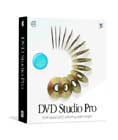
Says Chip Eberhart from Avenue Edit: "The biggest feature I'd like to see in the next version [of DVD Studio Pro] would be support for the industry standard subtitle format."
|
With the early 2001 release of Apple's DVD Studio Pro at a low price point of $1,000, the masses got access to their first full-featured authoring tool, which allowed them to create professional looking DVDs. Or did they?
As is often the case with new technologies, a few quirks arose. That raised some eyebrows, as well as questions, like: "Are frustrated users justified in their complaints about DVD Studio Pro's limitations?" And, "Are users expecting more than Apple promised to deliver with a budget-friendly tool in the first place?"

Apple says its latest version of DVD Studio Pro addresses many previous hiccups.
|
The answers depend on the user. Some who accept the product as a "prosumer" tool are still venting for various reasons. Others simply look toward more capable authoring tools for higher-end work.
INFORMED POINTS OF VIEW
When DVD Studio Pro was unveiled for this industry, it was billed as offering professional-quality DVD encoding, authoring and writing, and as the perfect complement to Apple's Final Cut Pro editing system.
While DVD Studio Pro has its critics, those who spoke to us for this story are mostly complimentary of the product and Apple (www.apple.com) in general, even while pointing out its imperfections. One or these pros is Ralph LaBarge, president of Alpha DVD (www.alphadvd.com) in Crofton, MD, (who uses DVD Studio Pro for OS X, Version 1.5.2). "First off, I think it's a wonderful product at that price point. It delivers many of the features included in DVD systems that run from $5,000 to $20,000. That's a very big positive."

While admitting to some bugs, Ralph LaBarge says DVD Studio Pro is "a wonderful product at that price point. It delivers many of the features included in DVD systems that run from $5,000 to $20,000."
|
Then comes the flip side. "There are a few bugs," he continues. "If the user is creating a dual-layer project, DVD Studio Pro puts the layer break in the wrong place, which can cause playback problems. And the subtitle editor crashes intermittently."
LaBarge adds that Apple is aware of these problems and is working on them. "People who develop DVD titles for the consumer market are not using it," LaBarge continues. "But lower-end, small runners of 1,000 copies or less are."
Kent Hodder took LaBarge's observations a few steps further. Hodder (who opted not to purchase DVD Studio Pro after test runs on OS 9, Version 1.5) is CEO at Digital Bucket (www.digitalbucket.com) in Minneapolis and also segued into his comments by offering a disclaimer: "We love Apple. Our entire creative services backbone is built on Apple's back," he explains. "Our graphics and animation facilities basically use After Effects on the Mac. Our Pro Tools audio suite and all of our Avid edit facilities exist only because of Apple and the affordability the corporation allows."

Digital Bucket's Kent Hodder, tried DVD Studio Pro but opted for Sonic Creator for pro projects like this one for The Job.
|
Then came his assessment of DVD Studio Pro. "We've tried it and basically set it aside, instead opting to use our Sonic Solutions Creator software. We've found that when we work on what I would call the more 'professional' projects, the benefits of using the expensive equipment outweighs the cost savings of DVD Studio Pro."
Hodder points to DVD Studio Pro's inability to manipulate the subtleties of shadowing and the nuances of shades of black or flashes of white. "The fact is that Apple's offering has limitations in taking full advantage of the DVD feature set. When you employ people who know how to perform those functions well, its kind of a shame if the tool they're trying to work with is underpowered."

The Job.
|
The bugaboo here concerns compatibility. Hodder says, "There is also a concern about compatibility of the DVD you spit out of a system like Apple's. Will it play in consumer decks? Windows-based computers?"
But, all told, he thinks the gist of this article could be completely different in three years. "To make DVD Studio Pro easier to use, they have purged certain concepts. This is a tool for the masses, in my mind. It's excellent for transferring home video to DVD, storage and possibly for the one-man band who needs to deliver on budget. So, DVD Studio Pro is a bargain for $1,000. But, at the end of the day, we feel we've shortchanged our product if we don't allow our people to use a tool that maximizes their efforts. So the additional benefit of Sonic is worth the extra expenditure."
Hodder's colleague at Digital Bucket, digital media developer Mark Sheldon, offered that most of its clients "go to great lengths to shoot on the highest quality format and expect the DVD to look as good as the master. Once it's on Digital Betacam, the Sonic will handle that straight off tape, without having to make it into a QuickTime movie."
With DVD Studio Pro, Sheldon continues, users can choose the bit rate, aspect ratio and field dominance, which is basically all the average consumer needs. "But once you get to the professional level, you need the ability to go in and analyze your streams and do re-encodes in certain areas of the video. Is there smoke in a scene? Lots of motion? Water? The issue is that in a pro system, you can tweak all of the nuances of the encoder to create a DVD that mirrors the master."
Jon Wenger (OS 9.2.2, V.1.51), DVD technical specialist with Zomax (www. zomax. com) in Fremont, CA, says the biggest downside of DVD Studio Pro is simply the lack of a good bundled MPEG encoder. "What they did was modify QuickTime to produce MPEG-2 encoded files, but the quality of the video suffers at lower bit rates."
And Chip Eberhart (OS X, V.1.5), director of DVD operations with Avenue Edit (www.avenue-edit.com) in Chicago, offers his take: "My opinion on the MPEG encoder is that it's good enough for entry-level users shooting on DV. If people are shooting on more professional standards like Beta, Digi Beta and HD, they need to invest in better encoding hardware, like what Sonic Solutions offers."
Overall, though, Eberhart pronounced DVD Studio Pro software up to scratch. "The biggest feature I'd like to see in the next version would be support for the industry standard subtitle format. I've got some customers, like ABC News, that send me subtitles. If I wanted to put them in DVD Studio Pro, I'd have to re-create them. I'm not going to spend time doing that, since I'd have to retype and reformat all of the subtitles into its subtitle editor."
Here's the LOVE
Those observations not withstanding, others speak glowingly of the product. Bruce Nazarian (OS 9 and X, V.1.5.2) is president of Gnome Digital Media (www.gnomedigital. com) in Burbank, a multi-faceted DV company, and also serves as an Apple trainer. He likes DVD Studio Pro.
He calls it "an extremely affordable, professional DVD authoring tool for the mass market" and is quick to point out that Apple has never maintained that this product was designed to go head-to-head with a $100,000 authoring system (or similar models that can cost up to $500,000). "What they have maintained is that DVD Studio Pro is extremely powerful and simple to learn to use. It's supposed to provide a thorough and reasonably complete DVD authoring environment with tremendous control, while nicely tying into Apple's video editorial workflow."
Typical users, he continues, would include major healthcare providers, nationally known public broadcasting organizations and countless independent companies that now embrace DVD Studio Pro as their technology of choice.
What he thinks is really needed is a clearer understanding of what DVD Studio Pro is - and isn't. "I hope beginning DVD authors understand that there is a learning curve, no matter what technology you use. Learning what DVD is before you try to build one is the best advice I can give."
That's why every class Nazarian teaches starts with two hours of DVD indoctrination. "I think the biggest mistake people make is that they don't understand the nature of the beast before they make a DVD," he says.
Comparisons between DVD Studio Pro and Sonic's DVD Creator or Sonic Scenarist are "unfair, given the significant differences between the products," he says. "Apple creates a lot of their sales promos on DVD Studio Pro. That's called eating your own dog food, isn't it? What better verification does the product need than that?"
Shane Ross (OS X, V.1.5.2), operations manager of Technicolor Sound Services Hollywood (www.technicolor .com), says, "Considering what's available on the market for authoring, I think DVD Studio Pro represents the best value for the investment."
Considering what the user gets for $1,000 is impressive to Ross, as he reels off the bullet points. "You get access to a large portion of the DVD spec, including multi-angle video, subtitles, AC-3 Dolby Digital encoding, authoring for DVD-9 discs with the Macrovision and Content Scrambling System. It also masters to Disc Descriptor Protocol (DDP) and CMF Cutting Master Format, as well as writes to a disc image, DVD-R or Digital Linear Tape (DLT, the standard format replicators expect).
"For my applications, it's a soup-to-nuts solution," Ross continues, though noting DVD Studio Pro currently lacks support for the karaoke mode and Digital Theatre Systems (DTS) audio (he said it also had a DVD-9 formatting issue that Apple addressed with Version 1.5.2, which is available for download at www.apple.com/dvdstudiopro). "I extol its virtues, especially from the point of value. There are issues with all software, so I focus on the positive side and discuss what I can do with it."
What such a system really does, Ross concludes, is offer a graphical front end of accessing parts for the DVD spec that would otherwise be tough to access in a less user-friendly context. "DVD Studio Pro's pop-up menus, graphics and drag 'n' drop interface allow for easy use and avoid the tediousness of using outdated command line interfacing that was prevalent in earlier DVD authoring systems. That's like using a computer with Microsoft Word instead of a typewriter or handwriting. Flaws and all, the computer application makes the work less tedious."
Analyzing why the aforementioned problems have arisen with DVD Studio Pro can be a matter of perspective, but one observer traced them back to the product's creation, by a German company called Astarte, which Apple purchased in 2000.
Apple Responds
Apple's director of product marketing for professional applications, Dave Edwards, cleared up some of these post pros' concerns. Edwards acknowledges that there was a problem "that affected a small number of dual-layer projects that were addressed by our recent update, 1.5.2. It solved the issues that were highlighted for us by our users." But in response to questions about subtitling and DTS Audio, Edwards simply stated that Apple is "continually looking for feedback from our customers concerning their needs."
As for future plans, Edwards stresses that "Apple does not comment on future product plans, but constantly listens to our customers to find out what they want from us." While reiterating that "the beauty of DVD Studio Pro is it offers a full set of DVD tools for a variety of markets without requiring the customers to understand the intricacies of the DVD spec," he concluded that the product has performed up to Apple's expectations.
Wenger makes the point: "With proper DVD spec knowledge, you can do some pretty incredible work with it. And the latest version seems to be reliable. But inexperienced users sometimes see an impressive project and expect to take DVD Studio Pro to Hollywood. An experienced user can make a silk purse out of a sow's ear, but that isn't what DVD Studio Pro is made for."
While the industry looks forward to the next edition of the product, speculation is that the Spruce product line, acquired by Apple in '01, will be mainstreamed as the new edition of DVD Studio Pro in the foreseeable future.
And while Hodder did not sugarcoat his points, he stresses that struggling with bugs in new technology is nothing new. "We encountered this situation when video cameras, Power Point and Final Cut Pro came out. This is about tools becoming more affordable. But no tool makes a user a creative force."